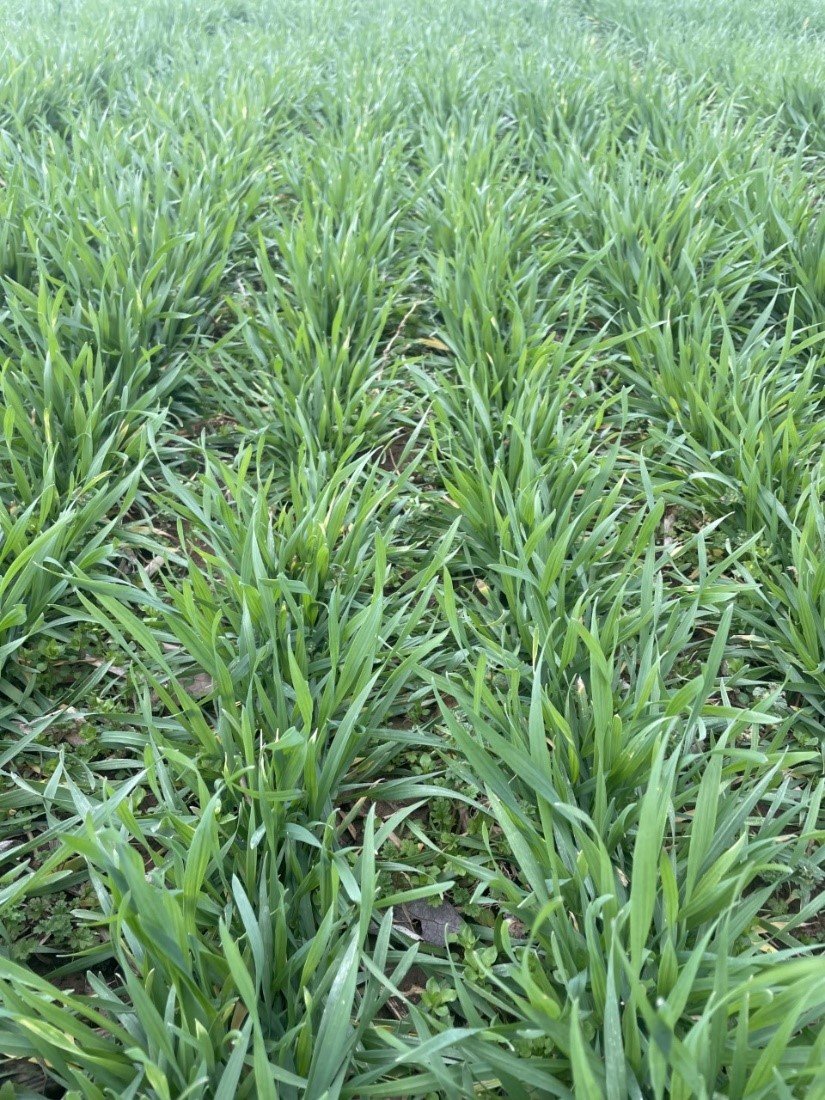How Could the Potential Warmest Winter on Record Affect Kentucky’s Wheat Crop?
Figure 1: Winter wheat in Princeton, KY 2/24/23. Despite the bitter cold temperatures in late December 2022, the wheat stands are good. Weed populations are equally “nice”.
Conner Raymond; Grain Crops Extension Associate
Dr. Carrie Knott; Grain Crops Extension Specialist
As the ‘meteorological’ winter ends (Dec 1 to Feb 28) for 2023, we are projected to have the warmest winter on record. This is impressive considering the sub-zero temperatures in late December 2022.
This has many people, including us, wondering:
What does this mean for Kentucky’s 2023 winter wheat crop?
First: We are fortunate that our current wheat crop is not excessively large, with excessive stands and tillers and at an advanced growth stage for this early in the season. Wheat with ‘excessive growth’ and at an advanced growth stage typically is at a much greater risk to be damaged by a spring freeze than moderate/acceptable stands. This year, we likely do not have excessive growth and advanced growth stages because the fall conditions were quite dry, which resulted in delayed emergence in most situations. In addition, the sub-zero temperatures during late December seems to have slowed down wheat growth enough to keep stands from becoming excessively thick.
Second: To compare how warm this winter has been, we examined the growing degree days (base temperature of 32°F) from December 1 to February 28 for this year and the years that the National Weather Service has identified as the “Top 10 Warmest” Winters for Paducah and Lexington. We chose these sites because the National Weather Service has a record of the top 10 warmest winters and because they likely represent the range of weather differences across the potential wheat growing regions within Kentucky.
Table 1. Ten warmest meteorological winters (December to February) since records began in December 1937 for Paducah, Kentucky (Source: https://www.weather.gov/pah/PaducahSeasonalRecords) and an “unofficial” estimate for the 2022/2023 meteorological winter from data available at the University of Kentucky’s Ag Weather Center. Source: http://weather.uky.edu/ky/data.php#KY_Climate_Data.
Table 2. Ten warmest meteorological winters (December to February) since records began in 1872 for Lexington, Kentucky (Source: https://www.weather.gov/media/lmk/climate/clilex/Top_Ten_Warmest_and_Coldest_Seasons.pdf) and an “unofficial” estimate for the 2022/2023 meteorological winter from data available at the University of Kentucky’s Ag Weather Center. Source: http://weather.uky.edu/ky/data.php#KY_Climate_Data.
Third: Since the winter of 2011-2012, seven of the last twelve winters have had above average GDD’s. Of those seven, three have resulted in late spring freeze events that have harmed the wheat crop (Table 3).
What contributes to a significant freeze event? Temperature, duration of temperature and plant growth stage are all factors to be considered. The majority of yield limiting damage occurs to wheat after Feekes 6, or jointing, when the growing point of the plant moves above the soil surface. Plants can withstand cold and even sub-freezing temperatures at this stage. However, if temperatures fall at or below 24°F for two or more hours moderate to severe yield damage can occur. If freeze damage is suspected it is important to wait seven to ten days with good growing temperatures, 40°F or above, before scouting. Even with above normal GDD’s, most of the wheat in the state has not reached jointing yet but will be approaching soon. Refer to AGR 253 and ID 125 if freeze damage is suspected.
Table 3. Growing degree days from December 1, 2022, through February 28, 2023 at Princeton, Lexington, and the Kentucky state average. Years highlighted in gray are years freeze damage was documented for wheat. Temperature data acquired from KYMesonet.org. Princeton 2022 data was not available.
We are painfully aware that this year our GDD’s rank second to the 2016-2017 season. Most of us recall vividly the late freeze that had us very concerned for the impact to our wheat crop (link here). Although multiple freeze events occurred that season, final wheat yields averaged 77 bu/A (the record breaking state average was the 2020-2021 season at 87 bu/A). This highlights the importance of closely monitoring wheat growth and development, particularly if freeze events are forecast. Should a freeze event occur, refer to AGR 253 and ID 125.
Conner Raymond, Grains Extension Associate
Dept of Plant and Soil Science
conner.raymond@uky.edu
348 University Dr. Princeton KY, 42445
Dr. Carrie Knott, Grain Crops Extension Specialist
Dept of Plant and Soil Science
carrie.knott@uky.edu
348 University Dr. Princeton KY, 42445




